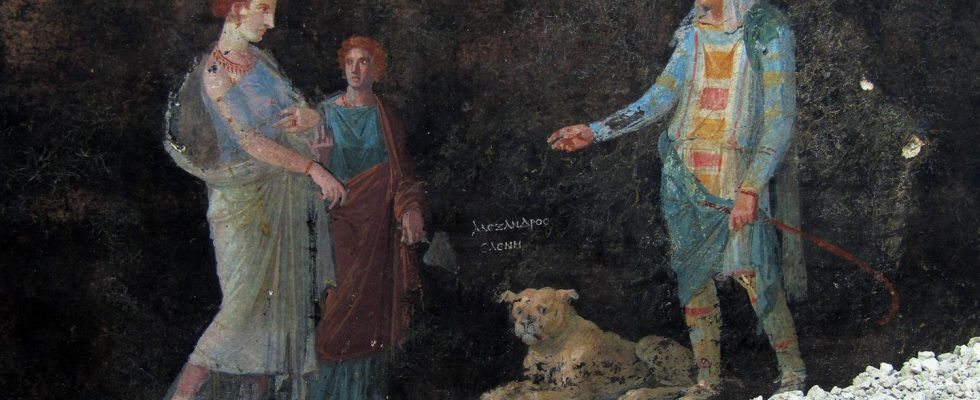“Black Room”
Archaeologists discover frescoes depicting the Trojan War in Pompeii
Portrait of Helena and Paris in the “Black Room” in Pompeii: The kidnapping of the Greek queen by the Trojan prince triggered the war
© Abacapress / Imago Images
Frescoes depicting paintings of the Trojan War have been discovered in a newly discovered “Black Room” in Pompeii. Italy’s culture minister was happy about another “surprise” from the buried city.
Spectacular find in Pompeii: During excavations in the ancient Roman city in southern Italy, archaeologists uncovered frescoes depicting the Trojan War. As the excavation site led by the German archaeologist Gabrielzuchtriegel announced on Thursday, the uncovered work of art is impressively large, measuring fifteen by six meters, and consists of images of various figures from the war sung about by the Greek poet Homer in the “Iliad”.
The Greek Queen Helena and the Trojan Prince Paris, who triggered the Greek war against the city of Asia Minor by kidnapping Helena, are depicted on a black background. You can also see, among other things, Paris’ sister Kassandra – who warned the Trojans in vain about the wooden horse given to them by the Greeks, in which Greek soldiers were hidden.
Gallery: New frescoes discovered in Pompeii
According to the head of the excavation,zuchtriegel, the illustrations served to entertain the guests of a Pompeiian house on Via di Nola, Pompeii’s longest street, and to encourage them to talk. In the room known as the “Black Room” because of the color of the walls Frescoes would probably have seen people meeting for banquets after sunset. One effect noted: Thanks to the painting’s dark ground, the trembling light of the oil lamps could give the impression that the painted figures were moving. “Especially after the viewer had drunk a few glasses of wine,” addedzuchtriegel.
A third of Pompeii is still buried under volcanic ash
Italy’s Culture Minister Gennaro Sangiuliano praised the discoveries as further evidence of the magic of Pompeii. The buried city “never ceases to surprise us, because every time we dig we find something beautiful and significant.”
According to the Guardian The newly discovered works are dated to the period between 15 BC and 40 to 50 AD. Pompeii was buried by an eruption of the volcano Vesuvius in 79 AD, but was unusually well preserved by the volcanic ash. The archaeological remains have been a UNESCO World Heritage Site since 1997.
Archaeologists believe that 15 to 20 percent of Pompeii’s population died in the volcanic eruption. Of the 22-hectare archaeological site, about a third is still buried under volcanic ash. The archaeological site near Naples is one of the most popular tourist destinations in Italy.


